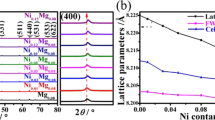Abstract
The purpose of this study is to find a ternary solid solution of nickel, magnesium, manganese in the alkaline-based cathode material (Na, Li) replacement with LiCoO2 that is too much expensive and toxic. Samples from the proposed {[(1–x–y) LiNi0.7Co0.3 (Al and Mg doped)] O2} system were synthesized using the sol-gel method. Stoichiometric weights of the LiNO3, Mg (NO3)2⋅6H2O, Mn (Ac)2⋅4H2O, Co(Ac)2⋅4H2O, Ni(NO3)2⋅6H2O as starting materials of lithium, magnesium, manganese , cobalt and nickel, in 28 samples of {[(1–x–y) LiNi0.7Co0.3 (Al and Mg doped)] O2}, respectively. We exhibited “Li1.167Ni0.117Co0.699Al0.017Mn0.167O2” is the best composition for cathode material. Obviously, the used weight of cobalt in these samples is lower compared with LiCoO2 that is an advantage in view point of cost in this study. With the same method we used (1–x–y) LiNi0.7 Co0.2Mg0.1, xLi2MnO3, yLiCoO2 composites and five samples have been found with the best conditions in viewpoints of capacity and cyclability. Among these samples with Li1.333Ni0.1Mg0.017Co0.551Mn0.333O2 structure is the best sample of those 28 compositions including Mg doped position. Charge-discharge characteristics of the mentioned cathode materials were investigated by performing cycle tests in the range of 2.4–4.6 V. Our results confirmed, although these kind systems can help for removing the disadvantage of cobalt which mainly is its cost and toxic, the performance of these kind systems are similar to LiCoO2 or NaCoO2 cathode materials.







Similar content being viewed by others
REFERENCES
Lithium Ion Batteries Outlook and Alternative Energy Vehicle (HEVs, PHEVs) Technologies, Markets, Competitors and Opportunities: 2010–2012 Analysis and Forecasts Market Research (Rockville, MD, 2010).
M. Yoshio, R. J. Brodd, and A. Kozawa, Lithium-Ion Batteries, Science and Technologies (Springer, New York, 2009).
B. Scrosati and J. Garche, J. Power Sources 195, 2419 (2010).
C. Daniel and J. O. Besenhard, Handbook of Battery Materials, 2nd ed. (Wiley-VCH, Weinheim, 2011).
R. A. Meyers, Encyclopedia of Sustainability Science and Technology (Springer, New York, 2012)
E. Rossen, C. D. W. Jones, and J. R. Dahn, Solid State Ionics 57, 311 (1992).
M. E. Spahr, P. Novák, B. Schnyder, et al., J. Electrochem. Soc. 145, 1113 (1998).
T. Ohzuku and Y. Makimura, Chem. Lett. 30, 744 (2001).
Y. Makimura and T. Ohzuku, J. Power Sources 119–121, 156 (2003).
Z. Liu, A. Yu, and J. Y. Lee, J. Power Sources, 81–82, 416 (1999).
M. Yoshio, H. Noguchi, J.-I. Itoh, et al., J. Power Sources 90, 176 (2000).
T. Ohzuku and Y. Makimura, Chem. Lett. 30, 642 (2001).
I. Belharouak, Y.-K. Sun, J. Liu, and K. Amine, J. Power Sources 123, 247 (2003).
J. K. Ngala, N. A. Chernova, M. Ma, et al., J. Mater. Chem. 14, 214 (2004).
W.-S. Yoon, K. Y. Chung, J. McBreen, and X.-Q. Yang, Electrochem. Commun. 8, 1257 (2006).
B. Ammundsen, J. Paulsen, I. Davidson, and R.-S. Liu, Electrochem. Soc. 149, A431 (2002).
M. M.Thackeray, C. S. Johnson, J. T. Vaughey, N. Li†, and S. A. Hackney, J. Mater. Chem. 15, 2257 (2005).
L. Zhang, H. Noguchi, and M. Yoshio, J. Power Sources 110, 57 (2002).
S. S. Shin, Y. K. Sun, and K. Amine, J. Power Sources 112, 634 (2002).
Hailang Zhang, Adv. Mater. Sci. Eng. 746341, 7 (2014).
G. M. Ehrlich and D. Linden, Handbook of Lithium-Ion Batteries (McGraw-Hill, New York, 2002).
Z.-G. Yang, J.-L. Zhang, M. C. W. Kintner-Meyer, et al., Chem. Rev. 111, 3577 (2011).
A. E. Galashev, O. R. Rakhmanova, K. P. Katin, M. M. Maslov, and Yu. P. Zaikov, Russ. J. Phys. Chem. B 14, 1055 (2020).
A. A. Kashmeri, F. Nawaz, M. Yousaf, A. Shameem, M. Shabir Mahr, J. Iqbal, M. Shafique and M. A. Javed, Russ. J. Phys. Chem. B 14, 552 (2020).
F. K. Fotooh and M. Atashparvar, Russ. J. Phys. Chem. B 13, 1 (2019).
Author information
Authors and Affiliations
Corresponding author
Rights and permissions
About this article
Cite this article
Samira Bagheri, Monajjemi, M., Ziglari, A. et al. Increasing the Performance of Cathode Material in Alkaline (Li, Na and K) Ion Battersis: Synthesis and Characterization. Russ. J. Phys. Chem. B 15 (Suppl 1), S140–S148 (2021). https://doi.org/10.1134/S1990793121090049
Received:
Revised:
Accepted:
Published:
Issue Date:
DOI: https://doi.org/10.1134/S1990793121090049




